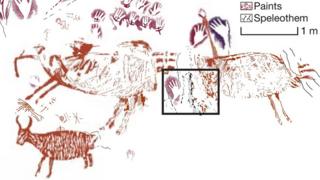'Oldest animal painting' discovered in Borneo
 Image copyright
NAture
Image copyright
NAture
The earliest known painting of an animal has been identified in a cave on the island of Borneo.
The artwork, which is at least 40,000 years old, is thought to be the oldest example of figurative painting - where real objects are depicted rather than abstract shapes.
The researchers aren't certain what animal it represents, but their hunch is that it's a banteng, a type of wild cow that lives in the area today.
The work appears in Nature journal.
The painting was found in a system of caves in the remote and rugged mountains of East Kalimantan, an Indonesian province on Borneo.
The caves contain thousands of other prehistoric paintings, drawings and other imagery, including hand stencils, animals, abstract signs and symbols.
"The oldest cave art image we dated is a large painting of an unidentified animal, probably a species of wild cattle still found in the jungles of Borneo - this has a minimum age of around 40,000 years and is now the earliest known figurative artwork," said Dr Maxime Aubert, from Griffith University in Australia.
The animal is one of a series of similar red-orange coloured paintings, which were made with iron-oxide pigment. These paintings, which include other depictions of animals along with hand stencils, appear to represent the oldest phase of art in the cave.
The animals, said Dr Aubert, are "painted in the same style with a large body and small legs".
The team managed to date two red-orange hand stencils, which yielded minimum ages of 37,000 years. A third hand stencil - an example of abstract, rather than figurative art - had a maximum age of 51,800 years, even older than the animal painting.
The authors conclude that rock art locally developed in Borneo between around 52,000 and 40,000 years ago, at roughly the same time as the earliest known art from Europe attributed to modern humans.
The second phase of painting in the cave is characterised by the use of purple-coloured paint, and dates to between 16,000 and 21,000 years ago. This phase includes some apparent depictions of humans.
Maxime Aubert said: "It looks like there was a transition from depicting the animal world to [depicting] the human world. And it's interesting because I think we have the same thing in Europe."
The area where the cave is located is relatively unexplored, so there could be many other examples waiting to be found.